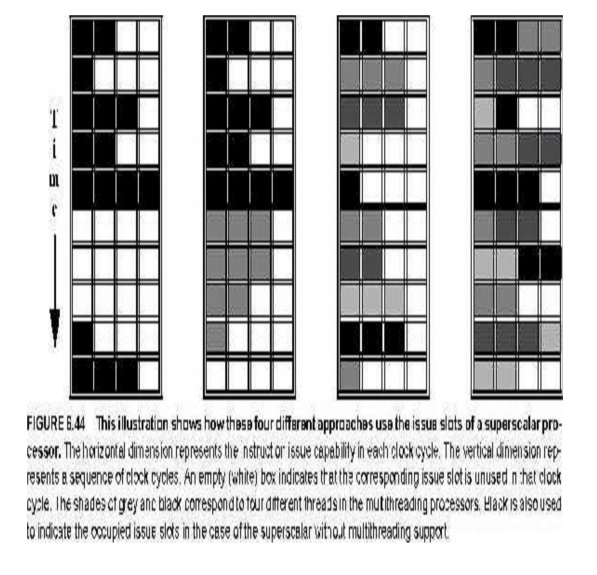Chapter: Advanced Computer Architecture : Multiprocessors and Thread Level Parallelism
Multithreading exploiting TLP
Multithreading
exploiting TLP.
1. Multithreading: Exploiting
Thread-Level Parallelism within a Processor
Multithreading allows multiple threads to share the
functional units of a single processor in an overlapping fashion. To permit
this sharing, the processor must duplicate the independent state of each
thread. For example, a separate copy of the register file, a separate PC, and a
separate page table are required for each thread.
There are
two main approaches to multithreading.
Ø Fine-grained
multithreading switches between threads on each instruction, causing the execution of multiples threads to be interleaved. This
interleaving is often done in a round-robin fashion, skipping any threads that
are stalled at that time.
Ø Coarse-grained multithreading was invented as an alternative to fine
grained multithreading. Coarse-grained multithreading switches threads only on
costly stalls, such as level
two cache misses. This change
relieves the need
to have thread- switching be
essentially free and is much less
likely to slow the processor down, since instructions from other threads will
only be issued, when a thread encounters a costly stall.
2. Simultaneous Multithreading:
Converting Thread-Level Parallelism into Instruction-Level Parallelism:
Simultaneous
multithreading (SMT) is a variation on multithreading that uses the resources
of a multiple issue, dynamically-scheduled processor to exploit TLP at the same
time it exploits ILP. The key insight that motivates SMT is that modern
multipleissue processors often have more functional unit parallelism available
than a single thread can effectively use. Furthermore, with register renaming
and dynamic scheduling, multiple instructions from independent threads can be
issued without regard to the dependences among them; the resolution of the
dependences can be handled by the dynamic scheduling capability.
Figure
6.44 conceptually illustrates the differences in a processor’s ability to
exploit the resources of a superscalar for the following processor configurations:
n a superscalar with no
multithreading support,
n a superscalar with
coarse-grained multithreading,
n a superscalar with
fine-grained multithreading, and
n a superscalar with
simultaneous multithreading.

In the
superscalar without multithreading support, the use of issue slots is limited
by a lack of ILP.
In the
coarse-grained multithreaded superscalar, the long stalls are partially hidden
by switching to another thread that uses the resources of the processor.In the
fine-grained case, the interleaving of threads eliminates fully empty slots.
Because only one thread issues instructions in a given clock cycle.
In the
SMT case, thread-level parallelism (TLP) and instruction-level parallelism
(ILP) are exploited simultaneously; with multiple threads using the issue slots
in a single clock cycle.
Figure
6.44 greatly simplifies the real operation of these processors it does
illustrate the potential performance advantages of multithreading in general
and SMT in particular.
3. Design Challenges in SMT
processors
There are
a variety of design challenges for an SMT processor, including:
Ø Dealing
with a larger register file needed to hold multiple contexts,
Ø Maintaining
low overhead on the clock cycle, particularly in critical steps such as
instruction issue, where more candidate instructions need to be considered, and
in instruction completion, where choosing what instructions to commit may be
challenging, and
Ø Ensuring
that the cache conflicts generated by the simultaneous execution of multiple
threads do not cause significant performance degradation.
In
viewing these problems, two observations are important. In many cases, the
potential performance overhead due to multithreading is small, and simple
choices work well enough. Second, the efficiency of current super-scalars is
low enough that there is room for significant improvement, even at the cost of
some overhead.
Related Topics